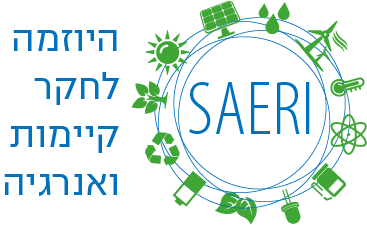מחקר
2014/15 Cycle
New Options for Solar Energy Conversion to Biofuel and Electricity
-
New Options for Solar Energy Conversion to Biofuel and Electricity
We aim at developing new energy-rich biomass sources, genetically engineered or selected fromnatural biodiversity, as biofuel feedstock and optimize biofuel production from the new biomass sources.
We have discovered wheat lines with highly digestible straw that could serve as feedstock for biofuel production (Levy, Barkai).
We are working on the expression of proteins in vivo for testing synthetic pathways for carbon fixation, predicted from computational design (Milo).
We have identified pretreatment conditions for the wheat straw substrate, which enables the native cellulosomes to completely convert the substrate into soluble saccharides for biofuel production (Bayer).
We have created new analytical infrastructures, with cutting-edge equipment that is unique in Israel for the analysis of lipids and carbohydrates involved in biofuel production (Aharoni).
New Options for Solar Energy Conversion to Biofuel and Electricity - Biofuels
-
Biofuels
We aim at developing new energy-rich biomass sources, genetically engineered or selected fromnatural biodiversity, as biofuel feedstock and optimize biofuel production from the new biomass sources.
We have discovered wheat lines with highly digestible straw that could serve as feedstock for biofuel production (Levy, Barkai).
We are working on the expression of proteins in vivo for testing synthetic pathways for carbon fixation, predicted from computational design (Milo).
We have identified pretreatment conditions for the wheat straw substrate, which enables the native cellulosomes to completely convert the substrate into soluble saccharides for biofuel production (Bayer).
We have created new analytical infrastructures, with cutting-edge equipment that is unique in Israel for the analysis of lipids and carbohydrates involved in biofuel production (Aharoni).
New Options for Solar Energy Conversion to Biofuel and Electricity - Optics
-
Optics
We aim at developing new methods for light concentration from macroscopic to microscopicscale, and means to use concentrated light for improved solar light harvesting efficiency for quantum conversion to electricity or fuels.
We focus on luminescent and other solar light concentrators, up-converters, and on hybridized plasmonic-semiconductor nonlinear optics (Oron, Davidson, Prior). We created luminescence up-conversion via nanocrystals with efficiencies of ~0.1%, at par with rare-earth based nanocrystals (Oron).
Using incoherent luminescence for up-conversion, we created plasmonic nanocavities that exhibit over 100-fold signal enhancement due to sub-wavelength focusing of light.
New Options for Solar Energy Conversion to Biofuel and Electricity - Photovoltaics
-
Photovoltaics
Our aim is to identify and understand the limits to organic solar cells and explore how to overcome these limits.
Our most significant achievement in photovoltaic research so far has been our use of a real organic-inorganic hybrid material with the perovskite1 structure for a high voltage photovoltaic cell. We demonstrated a low-voltage-loss cell with 1.3 V open-circuit voltage, and published the first article on this novel type of cell (“High Open-Circuit Voltage Solar Cells Based on Organic-Inorganic Lead Bromide Perovskite” Journal of Physical Chemistry Letters, 2013) (Cahen-Hodes).
We have demonstrated a new hybrid silicon/organic inversion solar cell (Cahen).
We have carried out extensive basic research on new “hole conductors” with a high potential for photovoltaic devices (Hodes, Rybtchinski, Bendikov). We performed and analyzed time-resolved characterization of organic/inorganic composites developed at the Technion for solar applications (Oron).
Lastly, we have developed a methodology to compute, using a DFT-based approach, optical excitation gaps for gas phase organic molecules.
--------------------------------------
1 Made from a material with the same type of crystal structure as the mineral calcium titanium oxide (CaTiO3) known as perovskite.
Other Projects
-
Homogeneously Microstructured Metal-Organic Frameworks for Efficient Energy Storage, Transport, and Release
Replacing our polluting, oil-driven economy with one based on renewable and clean energy sources requires advanced materials that can store, transport, and release this energy in the form of gaseous compounds. However, the efficient storage of energy in the form of dihydrogen (or methane, carbon mono-oxide), and its controlled release at practical temperature ranges and at constant and mild pressures is a challenging task. The aim of the proposed project is to be able to generate highly porous, uniform, and robust molecular materials that might be used in diverse real-world applications, including vehicles running on dihydrogen.
We have obtained new porous materials with natural gas (CH4) uptake capabilities that are reversible and comparable with commercially available Metal-Organic Frameworks (MOFs) such as Basolite.
-
Regulation and Biosynthesis of Algal Lipid Bodies
The natural ability of algae cells to accumulate high level of lipid-droplets serves as an attractive alternative for fossil fuel. Algae grow at very high rates, have high photosynthetic energy conversion efficiency, could use high level of CO2, furthermore each algal cell is an oil producer. Algae can be mass cultivated on waste or saline water in large areas not accessible for agricultural cultivation, avoiding competition with food production. The extracted algae oil is a drop-in fuel, which can be put into an immediate use, as it is fully compatible with current distribution storage and engines. Based on our previous studies, we propose to study the molecular, biochemical and genetic regulation of lipid-droplets accumulation in algae, to identify and to use key genes that control lipiddroplets production in unicellular algae for maximizing biofuel production.
-
Using flower petals as model system to elucidate plant genes controlling production of volatile alcohols having high biofuel properties
There is a major worldwide demand for new resources of energy, with plants being excellent sources of biofuel enhancing genes because their flowers produce multiple aromatic volatile compounds that could also be efficient biofuels. We plan to identify such volatile compounds and genes controlling their production, using petunia flowers that were genetically engineered to enhance the production of these volatile compounds from primary metabolism by transforming them with a bacterial gene proven to stimulate the conversion of primary to secondary metabolism. The identified candidate genes could later be introduced into other biological systems suitable for biofuel production, like photosynthetic algae.









